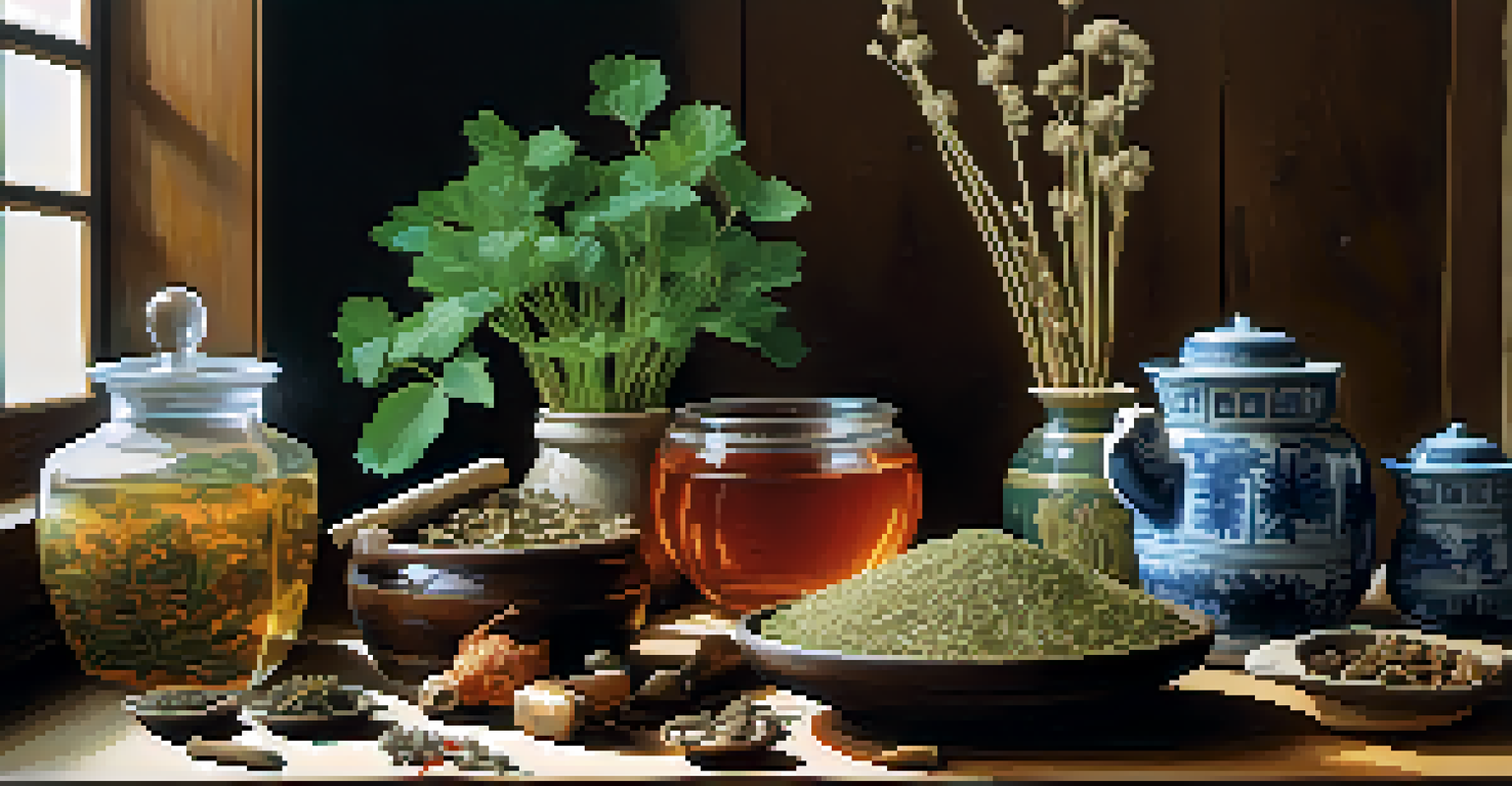Entheogens in Ancient Chinese Medicine and Philosophy

Understanding Entheogens: Definition and Context
Entheogens are substances that are often used in spiritual or shamanic practices to induce altered states of consciousness. In simpler terms, think of them as natural compounds that help people connect with deeper aspects of themselves or the universe. While commonly associated with various cultures globally, their presence in ancient Chinese medicine and philosophy is particularly fascinating and nuanced.
The greatest medicine of all is teaching people how not to need it.
In ancient China, entheogens weren't just tools for spiritual exploration; they were integrated into holistic healing practices. These substances were often viewed as sacred, believed to enhance the body’s natural healing processes. This perspective aligns with the broader Chinese philosophy emphasizing balance and harmony within the body and mind.
While many may immediately think of psychedelic substances, ancient Chinese entheogens included various herbs and plants, like ginseng or certain mushrooms. These natural elements served both medicinal and spiritual purposes, illustrating the deep intertwining of physical health and spiritual well-being in traditional practices.
Historical Roots of Entheogens in Chinese Practices
The use of entheogens in ancient Chinese traditions can be traced back thousands of years, woven into the fabric of Taoist and Buddhist practices. Historical texts often reference rituals where specific plants were consumed to achieve insight or enlightenment. This historical backdrop showcases how deeply embedded these substances were in the culture's quest for knowledge and understanding.

In Taoism, for instance, the concept of 'wu wei', or effortless action, is closely related to achieving a state of flow that entheogens are said to enhance. Ancient practitioners believed that certain herbs could facilitate a connection with the Tao, or the fundamental nature of the universe. This illustrates how entheogens served not only as medicinal aids but also as bridges to spiritual realms.
Entheogens in Ancient Chinese Practices
Entheogens were integral to ancient Chinese spiritual and medicinal practices, enhancing both healing and personal insight.
Similarly, Buddhist texts mention the use of specific plants during meditation practices. These substances were thought to help practitioners transcend ordinary thought processes, allowing for a deeper connection with their spiritual aspirations. This historical interplay of entheogens and spirituality highlights the multifaceted roles these substances played in ancient Chinese medicine.
The Role of Daoism and Entheogens in Healing
Daoism, a philosophy central to ancient Chinese culture, placed immense value on harmony with nature, and this worldview extended to the use of entheogens. Many Daoist practices involved herbal medicine, where practitioners used entheogens to restore balance in the body. This approach reflects a holistic understanding of health, emphasizing the interconnectedness of mind, body, and spirit.
Nature itself is the best physician.
For instance, the legendary figure of Zhang Sanfeng, often associated with Tai Chi and Daoist alchemy, is said to have used various herbs and mushrooms to achieve enlightenment and physical health. His teachings encourage practitioners to explore their inner selves, something entheogens can facilitate by promoting introspection and insight.
Moreover, the idea of cultivating 'qi', or life energy, is central to Daoist healing practices. Entheogens were believed to enhance the flow of qi, thereby supporting physical and mental wellness. This illustrates a profound understanding of the relationship between natural substances and the human experience, a philosophy that continues to resonate today.
Buddhism and the Spiritual Use of Entheogens
Buddhism, which gained a strong foothold in China, also embraced the use of entheogens in its spiritual practices. Many Buddhist monks sought enlightenment through meditation, and certain entheogens were believed to deepen this meditative state. This intersection of spirituality and natural substances highlights the flexible nature of ancient Chinese philosophies.
For example, the use of specific herbal brews during meditation sessions was thought to enhance mental clarity and focus. This practice aligns with the Buddhist goal of attaining 'nirvana', a state of liberation and enlightenment. By using entheogens, practitioners hoped to transcend worldly concerns and connect with a higher state of existence.
Modern Interest in Ancient Wisdom
There is a resurgence of interest in entheogens today, reflecting a broader movement towards holistic healing and traditional herbal medicine.
Additionally, the concept of 'mindfulness' in Buddhism parallels the experiences often described by those who use entheogens. Both seek to cultivate awareness and presence, allowing individuals to explore their inner landscapes. This shared goal underscores the complementary relationship between Buddhist practices and the use of entheogens in ancient China.
Medicinal Properties: Ancient Practices and Modern Insights
Ancient Chinese medicine recognized the potential medicinal properties of entheogens long before modern science began to explore them. Herbs like ginseng and certain fungi were noted for their healing capabilities, often used to treat a variety of ailments. This early recognition of the therapeutic benefits of these substances laid the groundwork for contemporary explorations into natural medicine.
Many of the plants used in ancient practices have now been studied for their pharmacological properties, revealing compounds that can enhance mental clarity, reduce stress, and even alleviate physical pain. This scientific validation brings a new layer of understanding to the ancient practices, connecting traditional wisdom with modern medicine.
Moreover, the holistic approach of ancient Chinese medicine, which considers emotional and spiritual health as integral to physical well-being, resonates with today’s increasing acceptance of alternative therapies. The integration of entheogens into healing practices serves as a reminder that the path to wellness is often multifaceted, blending ancient wisdom with modern insights.
Contemporary Perspectives on Entheogens in China
In recent years, there has been a resurgence of interest in entheogens within China, as well as globally. This revival reflects a broader movement towards exploring alternative healing practices and a renewed appreciation for traditional herbal medicine. As the world becomes more open to holistic approaches, ancient Chinese practices are being revisited and reinterpreted.
Additionally, modern researchers and practitioners are investigating the therapeutic potential of entheogens for mental health issues. From anxiety to depression, these substances are being considered for their ability to foster profound personal insights and emotional healing. This shift indicates a growing recognition of the value of ancient wisdom in addressing contemporary challenges.
Ethics of Entheogen Use
As interest grows, ethical considerations around the respectful and responsible use of entheogens are becoming increasingly important.
However, the journey isn't without its complexities. The legal and cultural attitudes towards entheogens vary significantly, and navigating these waters can be tricky. Yet, the dialogue surrounding entheogens in China is evolving, offering exciting possibilities for integrating ancient practices into modern health paradigms.
Ethical Considerations in the Use of Entheogens
As interest in entheogens grows, so too does the need for ethical considerations surrounding their use, especially in a culturally rich context like China. Approaching these substances with respect for their historical roots is vital, ensuring that practices do not exploit or trivialize their significance. This sensitivity is essential to honor the ancient traditions that have long revered these plants.
Moreover, there is a pressing need for education around safe and responsible use. With the rise of interest in entheogens, individuals must be equipped with knowledge about their effects, potential risks, and the importance of set and setting—the mindset and environment in which they are used. This education is crucial for ensuring the safety and well-being of those who choose to explore these paths.

Ultimately, by blending respect for tradition with modern understanding, we can create a framework for the responsible exploration of entheogens. This balance is key to ensuring that the wisdom of the past informs our approach to healing and spirituality in the present and future.